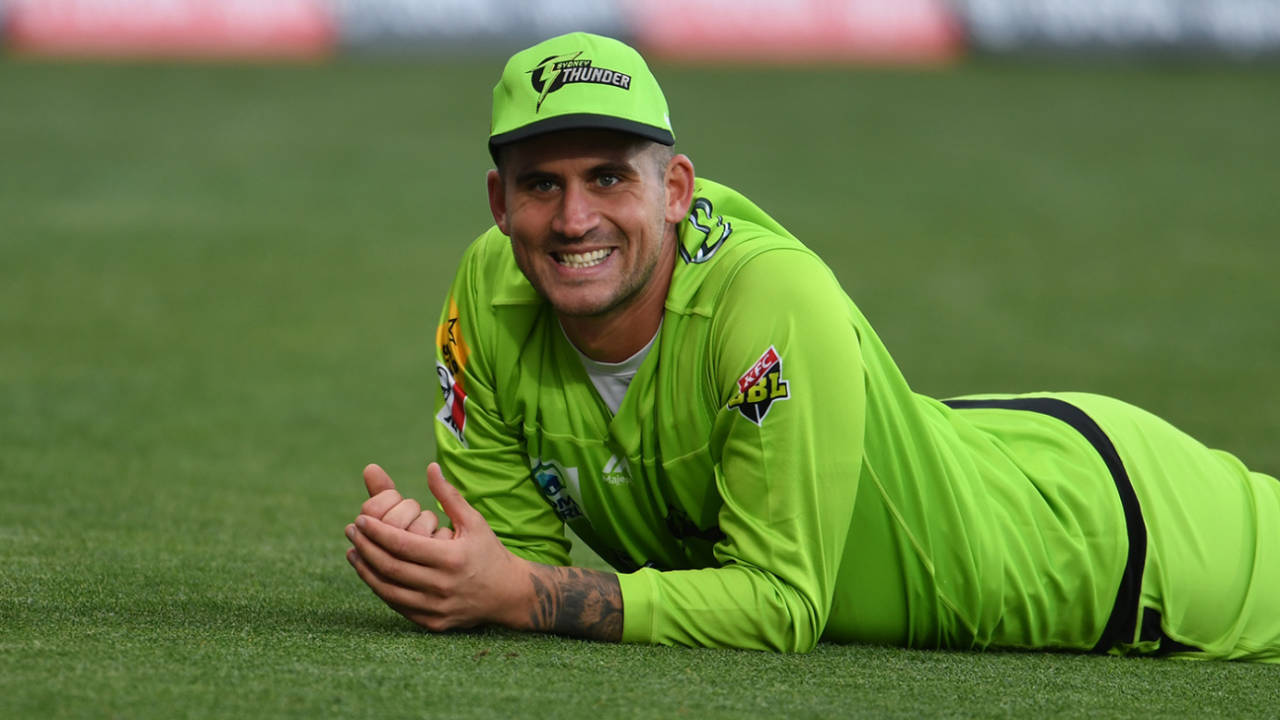Backtracking Hales, Zampa spark discussion at the BBL knockouts
Fielders move backward from 30-yard circle in anticipation of batsmen's actions within the game's laws
Matt Roller
31-Jan-2020
Getty Images
The first two knockout games of the Big Bash League season have brought to light the opportunity for innovation in the field made possible by a law change in 2015.
In Friday's qualifier between Sydney Sixers and Melbourne Stars, Moises Henriques was dismissed, caught at short fine leg, after Adam Zampa had taken several steps outside of the 30-yard circle immediately after Marcus Stoinis' point of delivery. Henriques was visibly frustrated by the decision, and eventually walked off after a long third-umpire review.
Similarly, in Thursday's eliminator between Sydney Thunder and Hobart Hurricanes, Alex Hales backtracked from his position at mid-off, as one of four fielders inside the 30-yard circle, though Simon Milenko's shot fell just short of him.
Hales' attempt initially led Ricky Ponting, commentating on Channel Seven's broadcast, to suggest that such an action "is actually cheating", adding that "anyone of us who have played the game, we know we're not allowed to walk back in the field. It's not against the rules but it's against the spirit of the game".
But such innovation in the field is not only permitted, but actively encouraged by the MCC's Laws of Cricket following a change made in 2015.
According to the updated Law 28.6, which governs "movement by any fielder other than the wicketkeeper", any movement by a fielder between the point of delivery and the ball reaching the striker is unfair except for the following: (28.6.1.1) minor adjustments to stance or position in relation to the striker's wicket; (28.6.1.2) movement by any fielder, other than a close fielder, towards the striker or the striker's wicket that does not significantly alter the position of the fielder; and (28.6.1.3) movement by any fielder in response to the stroke that the striker is playing or that his/her actions suggest he/she intends to play.
The change was made to encourage "intelligent fielding" and "skilful anticipation", according to MCC's head of cricket John Stephenson. Previously, that movement would have resulted in a dead ball being called. The ICC had previously introduced a change into their own playing conditions in September 2014, which meant that a catch taken in an ODI by Steven Smith - which had him move from slip to leg slip in anticipation of a paddle sweep - was deemed legal.
Since the BBL's playing conditions dictate that the fielding restrictions only apply "at the instant of delivery", Hales and Zampa were both permitted to move outside as soon as the ball had left the respective bowlers' hands.
Despite Ponting's initial response following the catch last night, Hales defended his actions, saying: "I don't think it's bad sportsmanship at all.
"I don't think there is anything wrong with trying to anticipate and trying to get one step ahead of the batter. Once the ball is let go and you see the batsman swing, you can react in the field and come forward or back. I think it's fine: it's part-and-parcel of fielding, trying to anticipate."
Interesting that walking in with the bowler to cut off a single is absolutely fine, but walking back on to the ring when they're teeing off is cheating?Never heard anyone talk about that in regards to the 'spirit of the game' in my entire career https://t.co/XdEhNKbii2
— Alex Hales (@AlexHales1) January 31, 2020
Glenn Maxwell, speaking on the player mic, agreed with that verdict following Zampa's catch, saying it was "very good fielding".
"As soon as you see a guy go to lap, he's taken off straightaway, the batter's probably predetermined that he's going," Maxwell said.
The third umpire was unable to confirm precisely where Zampa was stood at the instant of delivery, due to a lack of a camera angle, which panned away from where he was positioned at short fine leg just as Stoinis entered his delivery stride. That meant that the on-field soft signal stood, and Henriques was given out.
At the end of the innings, Zampa told Fox Sports that he couldn't be sure where he was at the point of release: "It's hard to say honestly. I saw him go back to ramp so I started sprinting. I actually wasn't even watching the ball [in the bowler's hand] I just watched the batsman and went back, so I don't know. It would be hard to tell to be honest."
Maxwell termed it "smart fielding" on Zampa's part. "They couldn't find enough video evidence, I think, to overrule it. But I think it's smart fielding. We do the same thing at cover and point, when you're trying to read the batter and his footwork, you're always running in the direction where you think the ball's going. If Zamps is bowling a shorter ball, I'm looking to go squarer. It's just anticipation - I thought it was really good fielding."
Ponting, too, appeared to have changed his verdict since Thursday's incident.
"What Glenn Maxwell's said there is exactly right," he said. "You are moving after the ball's released. As long as you're moving after the ball is released, then it's fine."
Matt Roller is an assistant editor at ESPNcricinfo. He tweets at @mroller98
